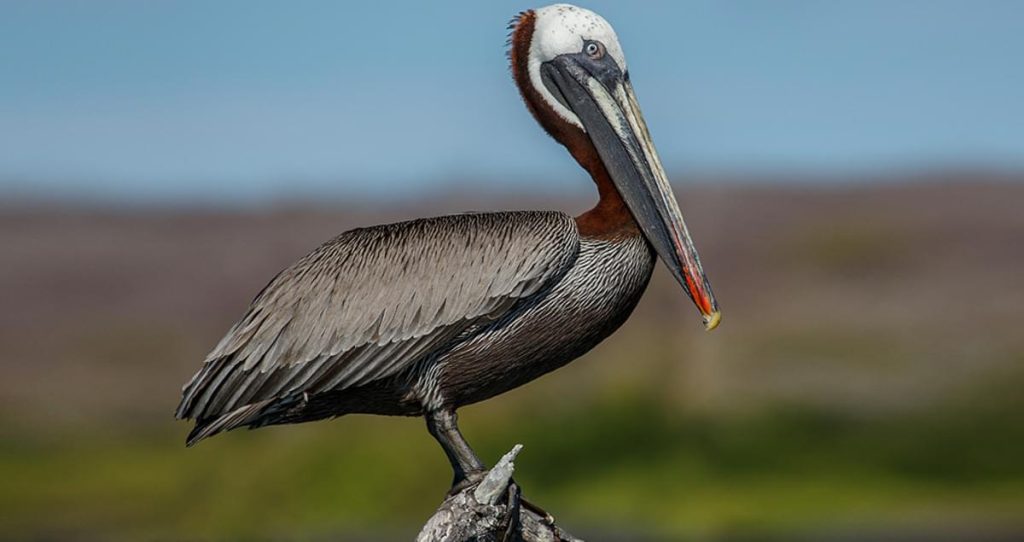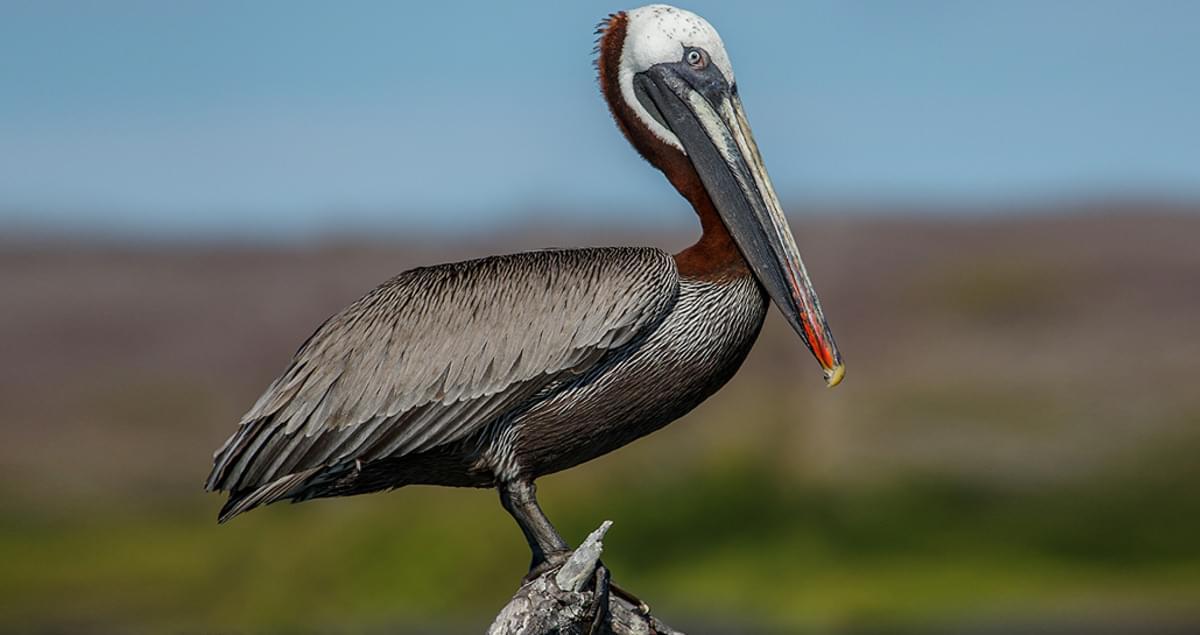In North America, Michigan is home to two distinct varieties of Pelicans. These remarkable birds are the American White Pelican and the Brown Pelican.
During the summer months, one can observe the presence of American White Pelicans in Michigan. However, Brown Pelicans are seldom seen in this region and are considered a rarity.
Pelicans, renowned for their immense size and distinct features such as their colossal bills, expandable throat pouches, and sturdy feet, stand as one of the largest avian species in the world. Surprisingly, despite their massive stature, they possess a remarkable lightness due to air pockets within their bones and skin, enabling them to effortlessly float. Additionally, their lengthy wings facilitate graceful soaring while in flight.
The global pelican population consists of eight different species, two of which inhabit the North American continent—the American White Pelican and the Brown Pelican.
During their breeding season, pelicans undergo notable changes in their facial skin, throats, and bills, which become more vibrant in color. Some even develop additional structures on their bills.
Pelicans exhibit a preference for communal breeding, forming colonies consisting of up to an astonishing 50,000 individuals. Depending on the species, these colonies may engage in ground-nesting or tree-nesting practices. After approximately 25 days of nurturing in the nest, the young pelicans congregate in “creches” composed of up to 100 fledglings. Remarkably, the parents possess the ability to identify and exclusively feed their own offspring.
While pelicans do prey on various animals, they do not fall under the classification of birds of prey, which is limited to raptors. Their diet primarily comprises fish, but they are known to consume crabs, frogs, snakes, mammals, birds, and insects.
To capture fish, pelicans employ their throat pouches, which they use to scoop up their prey and subsequently drain the water before swallowing. In the case of juvenile pelicans, they directly feed from their parents’ throat pouches.
For a comprehensive understanding of the Pelicans found in Michigan, this guide relies on avibase and data contributed by bird enthusiasts on ebird, providing genuine insights into the best times to spot these birds.
Michigan’s Pelican Species:
1. American White Pelican

The American White Pelican can be sighted in Michigan from March until mid-January, with the peak months for observation being April to October.
American White Pelicans are impressive aviators with the second largest average wingspan among North American birds.
During non-breeding periods, adult American White Pelicans exhibit an entirely white plumage, except for their black flight feathers, visible only in flight or when their wings are spread. Their eyes possess a bluish-gray hue, and their facial skin surrounding the eyes displays a yellow shade. Pale orange bills, pouches, and feet complete their distinctive appearance. Juveniles have light gray feathers with darker brown napes.
In the breeding season, adult American White Pelicans undergo a striking transformation in their appearance. They develop a yellow protuberance on their upper bills, resembling a horn. While their bodies remain entirely white, their eyes, bills, legs, and feet become more vividly orange.
American White Pelicans experience molting changes, referred to as “eclipse.” During spring, a visible yellowish patch emerges on their breast and chest, and in the summer, their heads acquire blackish feathers.
Scientific name: Pelecanus erythrorhynchos
Length: 60 – 63 inches (152 – 160 cm)
Weight: 246.4 ounces (6983 g)
Wingspan: 96 – 110 inches (244 – 279 cm)
American White Pelicans breed in remote inland lakes in North America and subsequently migrate to spend
their winters along the southern Pacific Coast of the United States, the Gulf of Mexico, Mexico, and Central America. They can be observed during migration across various states in the western and central regions of the US.
These pelicans favor shallow freshwater lakes, wetlands, and the fringes of lakes and rivers. During winter, they can be found in coastal bays, inlets, and estuaries, where they forage in shallow waters and rest on sandbars.
Their primary diet consists of fish. They employ a cooperative foraging technique, often in collaboration with other birds, to efficiently drive fish toward the shore, where they can easily scoop them up.
American White Pelicans are opportunistic feeders, adapting their feeding grounds to follow abundant food sources. They may travel considerable distances to find suitable locations and may also consume crustaceans, amphibians, and young birds. They are even known to pilfer fish from the water’s surface, snatching them away from other birds.
In terms of vocalizations, American White Pelicans are generally silent, emitting only occasional grunts. However, their young ones can become quite noisy within the large colonies, eagerly vocalizing to elicit food from their parents.
Nests of American White Pelicans are simple depressions on the ground, where twigs, sticks, reeds, and other materials are added for protection. The female lays one to two eggs, which both parents diligently incubate for approximately thirty-six days. Regrettably, due to siblicide (when one sibling kills another), only one chick from each nest survives.
Fun Fact: The impressive bill of the American White Pelican possesses the capacity to hold up to three gallons of water. When scooping fish from the sea, the pelican tilts its bill downward to drain the water, leaving behind the captured fish within its throat sac.
2. Brown Pelican

Brown Pelicans are infrequently observed in Michigan and are considered rare or accidental sightings. The most recent occurrences were recorded near Lake Macatawa in 2020.
Non-breeding adult Brown Pelicans typically feature white heads and necks, accompanied by pale yellow foreheads. Their extended bills exhibit a combination of yellow and orange hues. Their bodies display a grayish-brown coloration, complemented by short, black legs and webbed feet. Juveniles possess brown heads, necks, backs, and wings, with bluish-gray bills and a light brown underside.
The Brown Pelican comprises five subspecies, with two of them breeding within the United States. The Pacific Coast variant is known as P.o.californicus, while the Atlantic Coast variant is referred to as P.o.carolinensis.
The distinctions between Pacific and Atlantic Brown Pelicans become more apparent during the breeding season. Both species feature white heads with brighter yellow foreheads. However, their napes transition from white to dark brown, and Atlantic Brown Pelicans possess olive-brown throat pouches, whereas Pacific Brown Pelicans display red skin in their throat pouches.
Scientific name: Pelecanus occidentalis
Length: 48 – 50 inches (122 – 127 cm)
Weight: 131.2 ounces (3718 g)
Wingspan: 78 – 84 inches (198 – 213 cm)
Brown Pelicans breed, migrate, or remain residents along the Pacific and Atlantic coasts of North America, extending as far south as northern South America.
Brown Pelicans can be found in shallow water environments, residing year-round in estuaries and coastal marine habitats. They may also rest on mangrove islets, sandbars, breakwaters, and offshore rocks.
These pelicans possess a distinctive foraging technique that distinguishes them. They dive into the depths of the ocean to capture their prey within
their throat pouches. Upon resurfacing, they expel the water, allowing them to swiftly consume their catch.
Their diet primarily consists of fish, such as sardines and herring. When not diving, they casually swim and snatch prey with their bills. They may also consume crustaceans, amphibians, eggs, and young birds.
Adult Brown Pelicans tend to remain silent, with occasional grunting sounds. However, juvenile pelicans can be quite vocal, squawking in their attempts to solicit food.
Nests of Brown Pelicans are predominantly built on the ground, favoring islands, mangroves, and cliffs for concealment and protection. Females construct nests using reeds, leaves, pebbles, sticks, and soil. The female lays two to four eggs, which are incubated by both parents for approximately a month.
Fun Fact: Brown Pelicans practice incubation by covering their eggs with their webbed feet. However, this behavior proved detrimental to the species in the past when the pesticide DDT led to thinning of eggshells, causing them to break under the weight of the parents’ feet. Significant conservation efforts were necessary to restore the Brown Pelican population.
